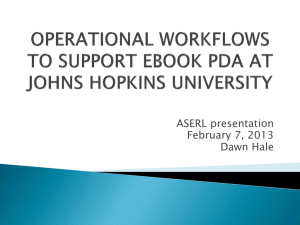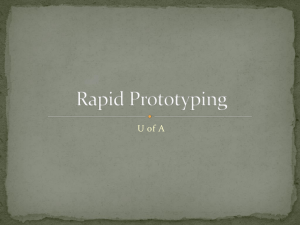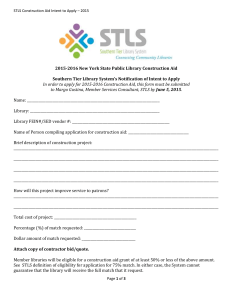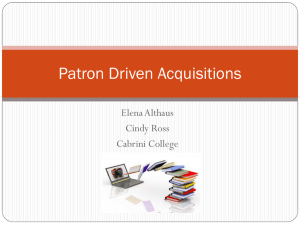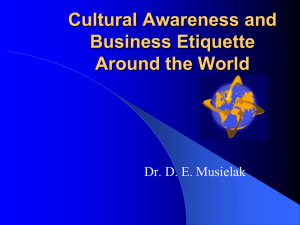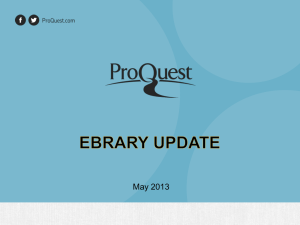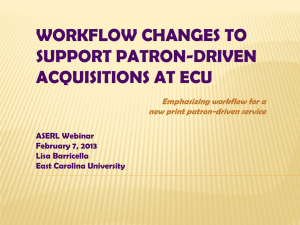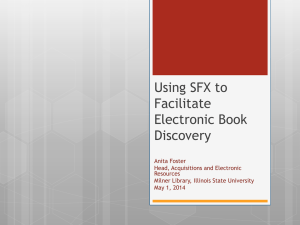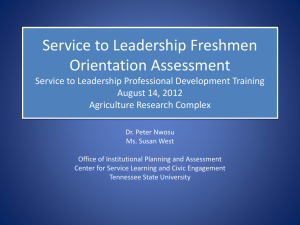Giving the Users What They Want: Is Patron
advertisement
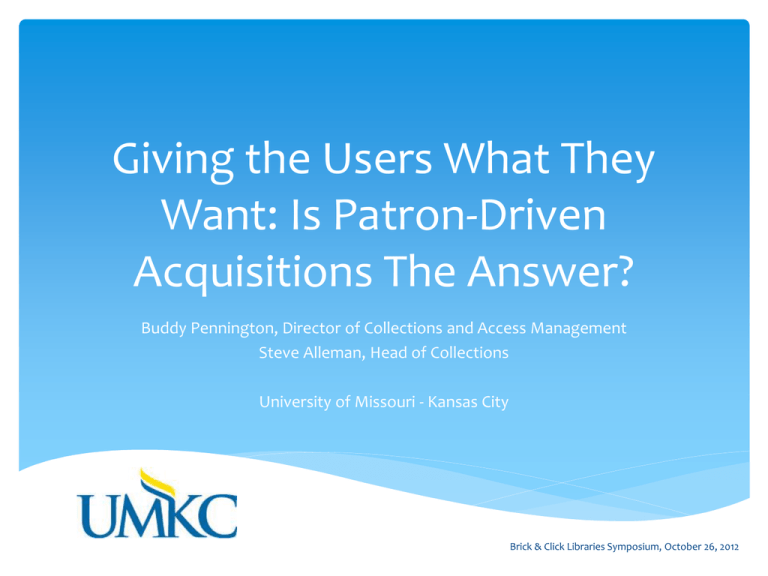
Giving the Users What They Want: Is Patron-Driven Acquisitions The Answer? Buddy Pennington, Director of Collections and Access Management Steve Alleman, Head of Collections University of Missouri - Kansas City Brick & Click Libraries Symposium, October 26, 2012 Background Huge increase in monograph publishing in recent decades Librarians lack time to invest in book selection Approval plans no better than firm orders at predicting use 30% of books purchased never get used Speculative buying – ‘just in case’ – has failed Declining circulation rates Declining budgets Increased demand for electronic resources Seamless delivery of content as a goal The Patron-Driven Approach Giving patrons what they want when they want it is more important than building collections for the future No funds are spent until demand is demonstrated Widest possible range of books to choose from Short-term loans satisfy patron needs cheaply ‘Retain selectively; distribute promiscuously’ Focus on e-books for seamless delivery of content Therefore no print-on-demand ebrary vs. EBL ebrary More titles but not all of them eligible for PDA More publishers than EBL Single-user preferred or multiple-user preferred are the only options. 50% upcharge for multiple-user PDA titles would supplement Academic Complete collection. Purchases triggered by: o Ten minutes, ten pages or any copying/printing triggers purchase OR o Three short-term loans (STL) trigger purchase. STL is 24 hour loan at 10-25% of list price for the book. EBL All titles eligible for PDA Leans towards the sciences; has some publishers (like Oxford) ebrary lacks All titles non-linear lending (multiple-user) List price for multiple-user Some crossover with ebrary Academic Complete collection Ability to select the the number of short term loans (STLs) before purchase is triggered Local Decisions Use YBP as our vendor EBL chosen as platform Profile wide-open, not based on approval plan No juvenile, cookbooks, or high school textbooks Price cap set at $500 Short term loan set at 24 hours Seven STLs before purchase is triggered Second copy must be bought after 325 loan instances Dedupe against ebrary Academic Complete but not against the print collection Implementation and Assessment Discovery records Usage (short-term loans and purchases) Expenditures Impact Conclusions Discovery Records Provided by YBP on a weekly basis Not OCLC records (customized 001 field) Include 590 note indicating PDA record If MARC record has LC call number (050) that gets added to item record to facilitate virtual shelf browsing in library catalog (3% lack call numbers) Discovery Record Loads Month Records Loaded May 54,627 June 2,087 July 5,981 August 2,882 September 3,971 October (1-15) 1,531 Subject Coverage Top Subjects by LC Class LC Classes with 1% coverage or less H – Social Sciences (21%) E (History of U.S.), N (Fine Arts) Q – Science (14%) S (Agriculture), M (Music) P – Language and Literature (11%) F (History of U.S.), Z (Library Science) R – Medicine (10%) U (Military Science) T – Technology (9%) C (Auxiliary Sciences of History) B – Philosophy, Psychology, Religion (8%) V (Naval Science), A (General Works) Above = 73% Above = 7% Usage Only 831 of over 70,000 titles show any usage: 19 have 5 or more uses 151 have 2-5 uses 661 have 1 use Short-Term Loan Usage 1,155 STLs (May – October 15) Spent $14,285.68 total $12.37 average price for STL In fiscal year 2012, we averaged $15,965.58 spent per month on our approval plans Month STLs Spent May 37 $749.27 June 151 $2,076.40 July 163 $1,949.51 August 186 $2,231.23 September 387 $4,451.12 October 115 $2,828.15 231 STLs by LC Class Class Coverage STLs H – Social Science 21% 25% Q – Science 14% 10% P – Language and Literature 11% 8% R – Medicine 10% 18% T– Technology 9% 5% B– Philosophy, etc. 8% 10% Total 73% 76% 1% or less LC classes = 7% coverage and 8% of STLs Education = 4% coverage but 6% STLs Average of 1 STL for every 62 titles. Music = 1 STL for every 22 titles. Agriculture = 1 STL for every 282 titles Purchases 12 purchases since May (6 in September, 3 in October 1-15) $1,190.91 spent $99.24 average per purchase First Five Purchases Title Publisher LC Class Paradise Found University of Chicago Press QH Official Guide for GMAT John Wiley & Sons Review* LB Introduction to LTE John Wiley & Sons TK Antigone; Oedipus the King; Electra Oxford University Press PA Motorcycle Diaries Ocean Press F *Karen S Fischer, Michael Wright, Kathleen Clatanoff, Hope Barton, & Edward Shreeves. (2012). Give 'em what they want: A one-year study of unmediated patron-driven acquisition of e-books. College & Research Libraries, 73(5), 469. Other Usage COUNTER usage: 3,958 sessions YTD (BR6) 2,589 searches YTD (BR6) 2,941 title downloads YTD (BR1) Other: 38 minutes average time for online reading Reports on # of days for download Pages accessed for individual titles Impact on Cataloging Discovery records loaded in by MOBIUS Consortium Office (we do not clean these up) Monthly reports of titles removed from EBL For purchases, receive OCLC record through WCP service. Requires MarcEdit intervention. Issues with not overlaying discovery record Issues with 856 fields Issues with crappy records Fewer print books results in changing workloads Impact on Book Selection Less speculative buying? Cancelling ALA print standing order Planning changes to YBP print approval plan Period Orders Estimated Price May – October 15, 2011 399 $31,995.74 May – October 15, 2012 261 $19,237.78 35% decrease 40% decrease ($12,757.96 in savings) Impact on Collections Budget $150,000 end-of-year deposit with YBP $14,285.68 spent on short-term loans (May-October 15) $1,190.91 spent on purchases (May-October 15) Expect both to increase over time as more titles are added Savings with fewer firm orders Next step: reduce print approval plan Conclusions Pretty happy with the results: good coverage, increasing access and usage, comfortable with spending money on the titles that are getting used Too early to budget for! (University of Newcastle spent $70,000 in five weeks) We don’t know who is using these materials “PDA…is establishing its place as a logical and responsive approach to developing library collections in the twenty-first century.”* *Candice Dahl (2012): Primed for Patron-Driven Acquisition: A Look at the Big Picture, Journal of Electronic Resources Librarianship, 24:2, 119-126 Questions? Buddy Pennington penningtonb@umkc.edu Steve Alleman allemans@umkc.edu
